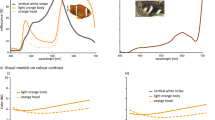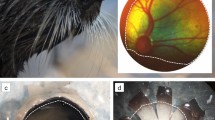Synopsis
Thirty one species of shallow water teleosts were captured from the NE coast of New Zealand. Ocular morphology was assessed in terms of eye size, pupil shape, theoretical sensitivity and acuity based on retinal morphology, and regional distribution of photoreceptors within the retina. Eye size was relatively or absolutely larger in carnivores than herbivores. Diurnal planktivores and nocturnal species of small body size maximise vision by having relatively large eyes. Anterior aphakic spaces were present in most of the species examined, and 25% of the species also had posterior aphakic spaces. Theoretical sensitivity was generally higher among nocturnal than diurnal species, however, a number of benthic and pelagic carnivores showed retinal specialization for enhanced sensitivity. Diurnal species displayed high spatial acuity, with maximum acuity occurring in carnivorous species. Crepuscular species had either high or low acuity, whereas that of nocturnal species was generally lower than in diurnal species. Ten species displayed regional variation in rod density, with crepuscular and nocturnal species showing streaks of high rod density in the retina. Eleven species of carnivores displayed regional variation in cone density, with highest density usually occurring in the caudal part of the retina. In most of the species with areas of high cone density, there was a forward visual axis that coincided with the location of the aphakic space, suggestive of accomodation along that axis.
Similar content being viewed by others
References cited
Abercrombie, M. 1946. Estimation of nuclear population from microtome sections. Anat. Rec. 94: 239–247.
Ali, M.A. 1975. Retinomotor responses. pp. 313–335. In: M.A. Ali (ed.) Vision in Fishes, Plenum Press, New York.
Anctil, M. 1969. Structure de la rétine chez quelques téléostéens marins du plateau continental. J. Fish. Res. Board Can. 26: 597–628.
Ayling, T. & G.J. Cox. 1982. Collins guide to the sea fishes of New Zealand, Collins, Auckland. 343 pp.
Boehlert, G.W. 1979. Retinal development in postlarval through juvenile Sebastes diploproa: adaptations to a changing photic environment. Rev. Can. Biol. 38: 265–280.
Collins, S.P. & J.D. Pettigrew. 1988a. Retinal topography in some reef teleosts. I. Some species with well developed areae but poorly developed streaks. Brain Behav. Evol. 31: 269–282.
Collins, S.P. & J.D. Pettigrew. 1988b. Retinal topography in some reef teleosts. II. Some species with prominent horizontal streaks and high density areae. Brain Behav. Evol. 31: 283–295.
Eastman, J.T. 1988. Ocular morphology in Antarctic notothenioid fishes. J. Morphol. 196: 283–306.
Fernald, R.D. 1985. Growth of the teleost eye: novel solutions to complex constraints. Env. Biol. Fish. 13: 113–123.
Fineran, B.A. & J.A.C. Nicol. 1974. Studies on the eyes of New Zealand parrot-fishes (Labridae). Proc. Roy. Soc. Lond. B 186: 217–247.
Helfman, G.S. 1986. Fish behaviour by day, night and twilight. pp. 366–387. In: T.J. Pitcher (ed.) The Behaviour of Teleost Fishes, Croom Helm, London.
Hobson, E.S., W.N. McFarland & J.R. Chess. 1981. Crepuscular and nocturnal activities of Californian nearshore fishes, with consideration of their scotopic visual pigments and the photic environment. U.S. Fish. Bull. 79: 1–30.
Hughes, A. 1977. The topography of vision in mammals. pp. 613–756. In: F. Crescitelli (ed.) Handbook of Sensory Physiology, Vol VII/5, Springer-Verlag, Berlin.
Kirschfeld, K. 1974. The absolute sensitivity of lens and compound eyes. Z. Naturforsch. 29: 592–596.
Locket, N.A. 1975. Some problems of deep-sea fish eyes. pp. 645–656. In: M.A. Ali (ed.) Vision in Fishes, Plenum Press, New York.
Lythgoe, J.N. 1979. The ecology of vision. Clarendon Press, Oxford. 244 pp.
Lythgoe, J.N. 1980. Vision in fishes: ecological adaptations. pp. 431–445. In: M.A. Ali (ed.) Environmental Physiology of Fishes, Plenum Press, New York.
MacDiarmid, A.B. 1981. Factors influencing the distribution and abundance of two temperate planktivorous reef fish, Pempheris adspersa and Scorpis violaceus. M. Sc. Thesis, University of Auckland, Auckland. 101 pp.
Marshall, N.B. 1979. Developments in deep-sea biology. Blandford Press, Poole. 566 pp.
Munk, O. 1966. Ocular anatomy of some deep-sea teleosts. Dana Rep. 70: 1–62.
Munk, O. 1970. On the occurrence and significance of horizontal band-shaped retinal areae in teleosts. Vidensk. Meddel. Dansk. Natur. For. 133: 85–120.
Munk, O. & R.D. Friederiksen. 1974. On the function of aphakic apertures in teleosts. Vidensk. Meddel. Dansk Natur. For. 137: 65–94.
Muntz, W.R.A. 1982. Visual adaptations to different light environments in Amazonian fishes. Rev. Can. Biol. 41: 35–46.
Muntz, W.R.A. & W.N. McFarland. 1973. The significance of spectral position in the rhodopsins of tropical marine fishes. Vision Res. 13: 1829–1874.
O'Connell, C.P. 1963. The structure of the eye of Sardinops caerulea, Engraulis mordax and four other pelagic marine teleosts. J. Morphol. 113: 287–329.
Pankhurst, N.W. 1987. Intra- and interspecific changes in retinal morphology among mesopelagic and demersal teleosts from the slope waters of New Zealand. Env. Biol. Fish. 19: 269–280.
Pankhurst, N.W. & J.N. Lythgoe. 1983. Changes in vision and olfaction during sexual maturation in the European eel Anguilla anguilla (L.). J. Fish Biol. 23: 229–240.
Paul, L.J. 1986. New Zealand fishes. An identification guide. Reed Methuen, Auckland 184 pp.
Pitcher, T.J. & J.R. Turner. 1986. Danger at dawn: experimental support for the twilight hypothesis in shoaling minnows. J. Fish Biol. 29 (Suppl. A): 59–70.
Pumphrey, R.J. 1961. Concerning vision. pp. 193–208. In: J.A. Ramsay & V.B. Wigglesworth (ed.) The Cell and Organism, Cambridge University Press, Cambridge.
Sadler, J.D. 1973. The focal length of the fish eye lens and visual acuity. Vision Res. 13: 417–423.
Saunders, A.J. & J.C. Montgomery. 1985. Field and laboratory studies of the feeding behaviour of the piper Hyporhamphus ihi with reference to the role of the lateral line in feeding. Proc. Roy. Soc. Lond. B 224: 209–221.
Schwassman, H.O. 1975. Refractive state, accomodation, and resolving power of the fish eye. pp. 279–288. In: M.A. Ali (ed.) Vision in Fishes, Plenum Press, New York.
Sivak, J.G. 1975. Accomodative mechanisms in aquatic vertebrates. pp. 289–298. In: M.A. Ali (ed.) Vision in Fishes, Plenum Press, New York.
Sivak, J.G. 1982. Optical characteristics of the eye of the flounder. J. comp. Physiol. 146: 345–350.
Somiya, H. 1987. Dynamic mechanism of visual accomodation in teleosts: structure of the lens muscle and its nerve control. Proc. Roy. Soc. Lond. B 230: 77–91.
Tamura, T. & W.J. Wisby. 1963. The visual sense of pelagic fishes, especially the visual axis accomodation. Bull. Mar. Sci. Gulf. Carib. 13: 433–448.
Thompson, S. 1981. Fish of the Marine Reserve: a guide to the identification and biology of common coastal fish of northeastern New Zealand. Leigh Laboratory publication, University of Auckland, Auckland. 364 pp.
Author information
Authors and Affiliations
Rights and permissions
About this article
Cite this article
Pankhurst, N.W. The relationship of ocular morphology to feeding modes and activity periods in shallow marine teleosts from New Zealand. Environ Biol Fish 26, 201–211 (1989). https://doi.org/10.1007/BF00004816
Received:
Accepted:
Issue Date:
DOI: https://doi.org/10.1007/BF00004816




